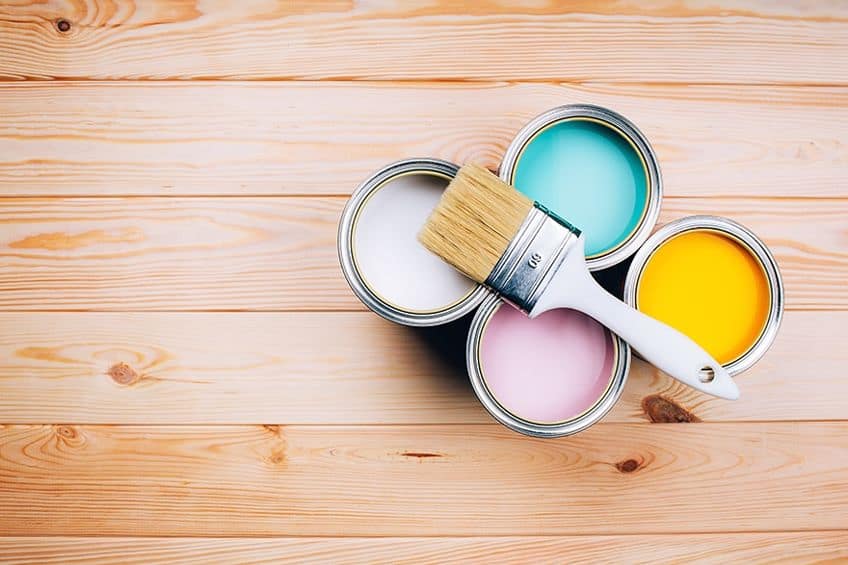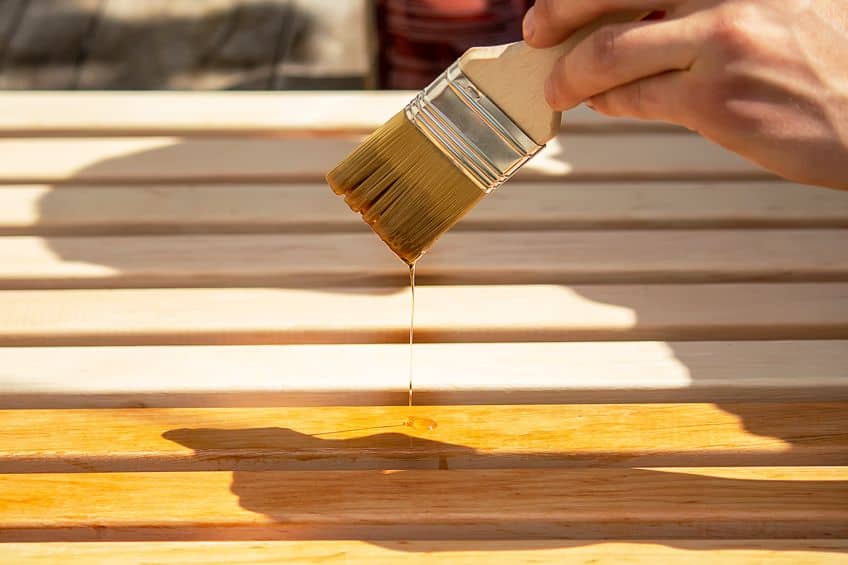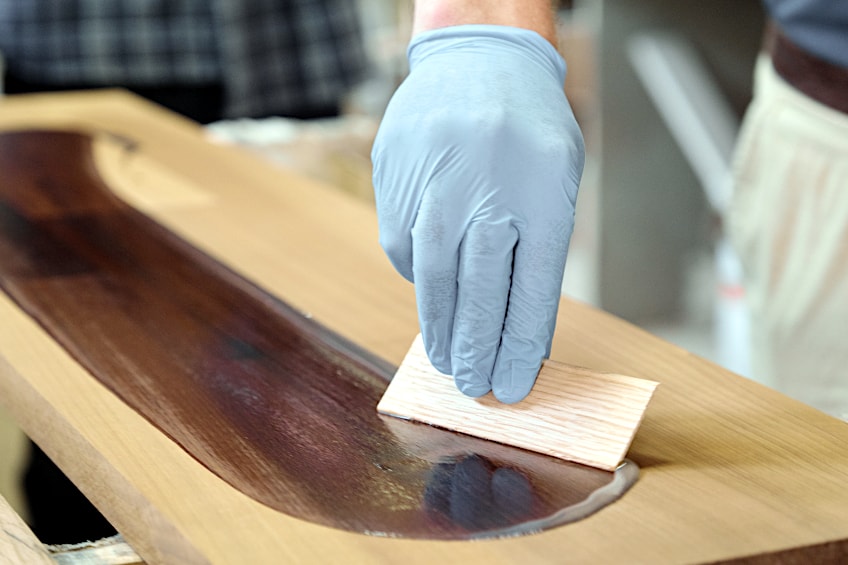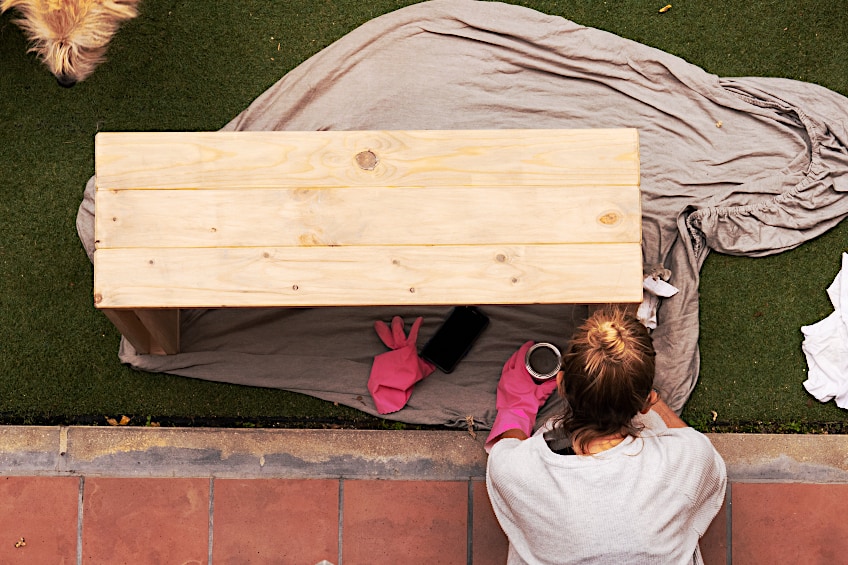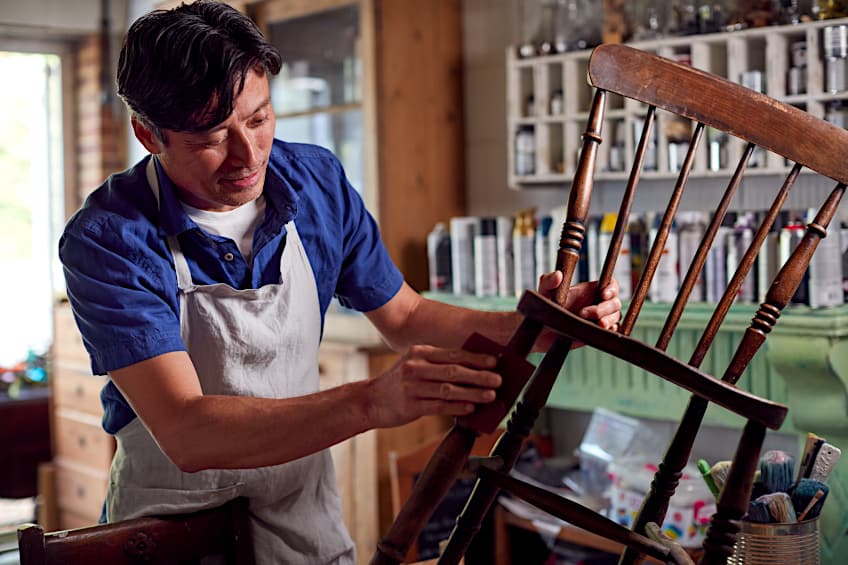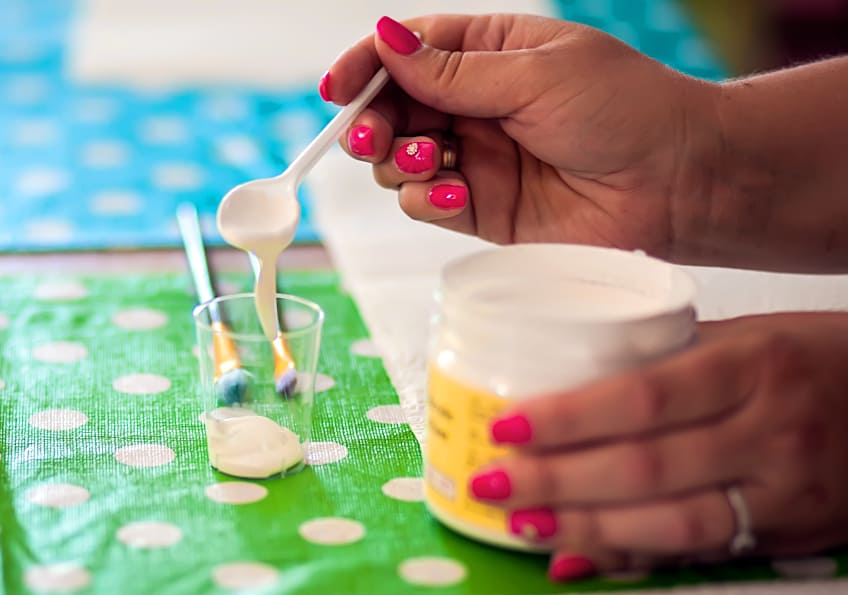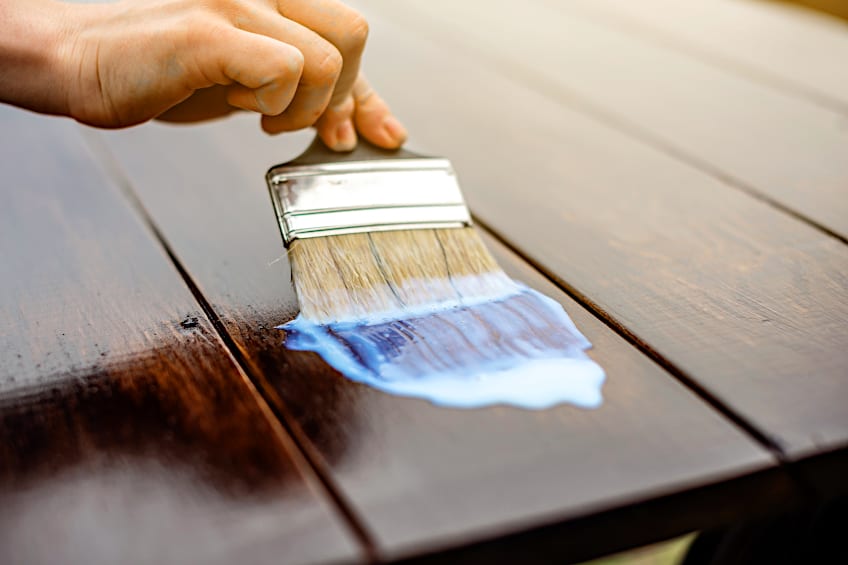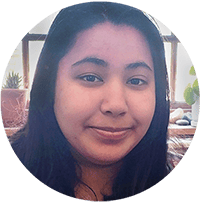How to Seal Acrylic Paint on Wood – Different Acrylic Paint Sealers
Acrylic paint is relatively new considering that water and oil-based paints have been around for hundreds of years. Even though it’s the new kid on the block, acrylic paint has become increasingly popular due to how easy it is to use, the fact that it’s readily available, and the fact that it’s rather durable. It isn’t quite as durable as some other paint types though, which is why most crafters seal their paint once it has dried and cured. There are many advantages to sealing acrylic paint, so let’s have a look at how to seal acrylic paint on wood, why sealing acrylic paint on wood is a good idea, and how exactly acrylic paint sealer works.
Contents
What Is Acrylic Paint?
Before we show you how to seal acrylic paint on wood, we thought we’d get into what exactly acrylic paint is and why it needs to be sealed, to begin with. Many paint types don’t need to be sealed due to their inherent nature, and while acrylic paint is durable, it is not infallible. Acrylic paint consists of pigment, solvent, and binders that have been suspended in the acrylic polymer. It is a simple composition that allows the paint to adhere to most surfaces with little to no preparation required. Once the paint has adhered to the surface of your workpiece the solvents start to evaporate. How does this happen? “solvents” in acrylic paint are usually water or alcohol-based, which allows them to evaporate when thinly spread and/or exposed to certain temperatures.
Once the solvent begins to evaporate the acrylic polymer will also begin to harden, leaving behind just the hardened polymer and the pigment that has been suspended in it. Pretty cool right? This makes acrylic paint usable on metal, wood, plastic, and even glass surfaces with a little bit of preparation beforehand.
It is also durable. Acrylic paint has a reasonable degree of resistance to impact, abrasion, heat, moisture, mold, and insect infestation. It contains few VOCs (volatile organic chemicals) which means that it can be used both indoors and outdoors without having to worry about nasty fumes or funny smells completely enveloping the space. It isn’t perfect though. Acrylic paint can also easily be removed or damaged if left untreated. Because a fair percentage of its composition consists of water, if enough water is applied to an acrylic paint coating it will run and dissolve. Additionally, if exposed to open flamed or directed heat, it can raise and peel away from the surface of your workpiece.
Why Should You Seal Acrylic Paint?
Sealing acrylic paint once it’s been applied to a wooden workpiece is a great way to ensure that your finish lasts for a long time while preserving the aesthetic and integrity of your surface. In case you’re on the fence about it, we’ve prepared a short tutorial detailing why acrylic paint sealer benefits you and your workpiece in the long run.
It Protects Your Finish
One of the most common reasons for sealing acrylic paint on wood is the fact that it protects the surface of your workpiece from exterior forces. If your workpiece is going to spend most of its time outdoors it’s a good idea to seal the surface to ensure that moisture, sunlight, insects, and mold don’t distort or lift your finish.
Improves Aesthetic Appeal
If you’re going to spend hours perfecting the look of your workpiece, why not take things one step further? Applying a sealer to the surface of your workpiece will give it a glossy, reflective finish that’s sure to turn some heads.
Sealer is a cheap and highly effective means of classing up the look of acrylic paint, especially if the color scheme is muted.
It Increases Surface Friction
If you’ve ever slid across a freshly polished wooden floor on your socks, then you know how slippery wood can get. If you’ve painted your wooden floors, it can still be a bit slippery (less so than unpainted though), so why not put a healthy layer of sealer over the surface? Not only will this make it less slippery, but it will ensure the scuff marks and scratches don’t ruin the surface of your flooring and/or workpiece.
Reduces Maintenance
One of the best things about sealing your wooden workpiece with wood sealer is that it drastically reduces the maintenance requirements. Not only will water and grime wipe right off the surface, but you would need to polish the surface of your workpiece or reapply your acrylic paint either.
In doing this, it will save you quite a bit of time and money in the long run.
Better for the Environment
While the production of sealers undoubtedly has a negative effect on the environment, since you only need to use it once and store the rest, the overall cost to the environment is reduced. You don’t need to reapply your finish every couple of years, which means you buy less paint, which means a fraction of less paint is produced, which means less paint is wasted, leading to a healthier environment!
How to Seal Acrylic Paint on Wood
Now that you know why it’s a good idea to seal acrylic paint on wood we thought we’d show you how to do it, as well as a few products you can choose from to get the job done. It’s pretty easy stuff, and there are many helpful tools and techniques you can use if you’re going to be trying it for the first time!
That being said, here are a few products and techniques for you to try out.
What Is the Best Acrylic Paint Sealer for Wood?
This is a difficult question to answer. Not only does it depend on the type of wood you’re working with, but you also need to consider the shape of your workpiece, where it will be situated, and how much time you’re willing to spend applying your sealer. Here are a few finishes you’ll encounter when purchasing an acrylic paint sealer.
| Sealer | Properties |
| Liquid Acrylic Varnish | ● Highly durable ● Creates a muted finish ● Readily available ● Easy to use ● Can be used on most wood species ● Can be used indoors and outdoors |
| Acrylic Resin Varnish | ● Highly Durable ● High sheen finish ● Readily available ● Easy to use ● Can be used indoors and outdoors ● Can be used on multiple wood species |
| Mod Podge | ● Moderately durable ● Creates a muted finish ● Readily available ● Inexpensive ● Easy to use ● Can only be used indoors ● Can be used on most wood species |
| Polycrylic | ● Moderately durable ● Can create satin, gloss, and matte finish ● Readily available ● Easy to use ● Inexpensive ● Can only be used indoors ● Can be used on most wood species |
Liquid Acrylic Varnish
Liquid acrylic varnish is one of the best options when it comes to protecting your acrylic paint. It can be used on a number of surfaces to achieve a shiny finish and is fairly easy to apply compared to other protective coatings like acrylic resin and conventional varnish. It’s also readily available and can be used on photographs, cardboard, and even plastic to a degree. The protective layer created from this coating is capable of withstanding forces such as impact, abrasion, UV light, directed heat, open flames, insects, and mold.
This ensures that your acrylic paint coating is always protected from exterior forces, and you won’t have to touch up your surface or maintain its sheen for a very long time.
How to Apply Liquid Acrylic Varnish
Before applying liquid acrylic varnish you should ensure that the surface of your workpiece is clean. Use a clean cloth to remove any dirt from the surface of your workpiece. Next, use some fine sandpaper to lightly sand the surface of your workpiece. This will create more surface friction, allowing the acrylic varnish to set into the surface of the paint. Wipe away any dust created through the sanding process and ensure that the surface is completely clean before you begin to apply your acrylic varnish sealer. Next, give your container a good shake, open it up, and get some on your brush. Apply the acrylic varnish evenly across the surface of your workpiece and allow it to dry and cure for the manufacturer’s recommended time period.
Acrylic Varnish Resin
Acrylic varnish is one of the few coatings on this list that has been specifically designed to coat painted surfaces. If you’re wondering how to seal acrylic paint on wood outdoors, this is the stuff you’re looking for. Acrylic resin varnish is essentially acrylic resin and is commonly used to create a strong layer of acrylic thermoplastic on top of your painted surfaces. Like many other protective layers for wood, this one is pretty robust and can be applied with relative ease given that you have the right tools and that you know how to use it effectively.
The nice part about acrylic varnish resin is that it can be applied in various degrees of thickness depending on the application of your workpiece and your personal preference.
How to Apply Acrylic Resin Varnish
Before you apply your acrylic resin varnish you should ensure that the painted surface has been prepared correctly. Start off by lightly sanding the surface of your workpiece with some fine grit sandpaper. Ensure that the surface is sanded evenly or you could end up ruining the look of your paint. Finally, ensure that you remove all of the paint dust from the surface with a clean cloth. Next, pour some acrylic resin into a smaller container so that it’s easy to manage and get some on your brush. Start applying the resin to the surface of your workpiece, making sure to follow the length of the board so that you get the most coverage possible. Repeat this process until the entire surface of the board has been covered and allow the resin to dry for the manufacturer’s recommended time period. Again, if you’re wondering how to seal acrylic paint on wood outdoors, this is by far the best method.
Mod Podge
Mod podge is extremely versatile and has been used for a number of applications both in and out of crafting. It is a combination of glue and clear sealant for wood that is usually used to adhere paper and photographs to ceramic surfaces in the decoupage craft. Unlike conventional glue, pod podge is applied over the image instead of underneath it, soaking through the image to adhere it and simultaneously sealing the surface. As you can imagine this is quite useful and can be used to seal acrylic paint as well. Unfortunately, pod podge is not very durable, but it is quite cheap and readily available.
The quality of mod podge can vary considerably by brand and price, so be sure to check out reviews and tutorials to ensure you get the best possible mod podge for your money. Regardless, modge podge is a trusted clear sealant for wood.
How to Apply Mod Podge
when inside the container. Applying mod podge is super easy, all that you need to do is prepare your surface and then apply the mod podge. Sanding isn’t explicitly necessary when applying mod podge, but you can give your painted surface a good once over with a damp cloth to ensure that it is clean. Give your mod podge a good shake and then get some on your paintbrush. Start applying it to the surface of your workpiece following the length of the board. If your workpiece is circular or irregularly shaped you can work from the center outward or vice versa. Regardless, repeat this process until the entire surface has been covered and allow it to dry for the manufacturer’s recommended time period.
Polycrylic Sealer
When it comes to sealing painted wood one of the most popular choices is polycrylic sealer. Polycrylic is a derivative of acrylic acid that has been used specifically for light-duty wood protection. Polycrylic is water-based, dries quickly, is relatively durable, easy to use, and can be found in most lumber and crafting stores. It is also relatively inexpensive. Sealing painted wood with polycrylic is always a good idea, but only if your workpiece will be situated indoors. Why? Since polycrylic is water-based it won’t last very long outdoors, especially if you live in an area with lots of humidity and rain.
However, it stands up to abrasion and light impact quite well, making it a good fit for highly trafficked wooden floored areas of the home.
How to Apply Polycrylic Sealer
Polycrylic sealer is available in conventional brush-on form and as an acrylic paint sealer spray. As you would with acrylic resin, the best way to ensure your acrylic finish is properly preserved by the sealer is to give the surface a light sanding. Once you’ve sanded the surface clean off the paint dust with a clean cloth or by using some compressed air. If you’re using a brush and roller to apply your polycrylic sealer we recommend starting off with a conservative amount first to get used to consistency. Like with any other coating, apply your sealer along the length of the board following the wood grain. If your workpiece is quite big simply work section by section, applying an even coat of sealer throughout the process.
If you are using an acrylic paint sealer spray, start by spraying off the workpiece and then move your wrist in one smooth, uninterrupted motion across the surface of your workpiece. Ensure to apply even pressure throughout the pass until you reach the other end of the board. Stop once you’re slightly off the other end of the board, and repeat this process until the entire surface of your workpiece has been covered. If your workpiece is bigger, the acrylic sealant spray could be better as it will save you some time and effort. If your workpiece is smaller, a brush might be better since it provides you with better control over the application process. Regardless, once your sealer has been applied, allow it to dry and cure for the manufacturer’s recommended time period before making use of your workpiece.
Now that you know why it’s a good idea to seal a surface painted with acrylic paint, some of the different types of sealers available to you, when you should use a brush or acrylic sealant spray, and how to use each of these products, it’s time for you to get out there and put your newfound knowledge to the test. Remember to always work in a well-ventilated area and to protect your hands, eyes, and mouth when working with aerosolized products.
Frequently Asked Questions
What Is the Best Waterproof Acrylic Sealer for Crafts?
If you are looking for the best waterproof acrylic sealer for crafts, look no further than acrylic resin varnish. Not only is this substance waterproof, but it protects your workpiece from impact, abrasion, moisture, and even UV light!
What Is the Best Way to Seal Acrylic Paint?
This depends on the application. If your workpiece will be situated outdoors, then the best tool for the job would be acrylic sealer varnish. If your workpiece will be situated indoors, then you should be able to get away with using anything from mod podge to polycrylic sealer. The best way to seal acrylic paint is to take the application of your workpiece into account and choose the most robust sealer designed for that application.
Should You Seal Acrylic Paint?
This depends on what your surface will be doing throughout its lifetime. Is your surface a painted floor or outdoor furnishing? In this case, you should almost definitely seal your surface. If your workpiece is going to be on a shelf for the rest of its life, this might not be necessary.
Megan is a writer and researcher who holds a degree in Social Sciences, with a specialization in Psychology and Environmental Science, from the University of Cape Town. Her dedication to acquiring knowledge and making a positive impact has driven her current work in promoting conscious and sustainable growth in Southern Africa. Megan’s interests encompass exploring the physical and psychological impacts of color in our environment on our mood and well-being. She is also passionate about the role of art and creativity, which has been an integral part of society since the beginning of human history. Since 2022, Megan has been contributing blog posts on painting and color theory at artfilemagazine.
Learn more about Megan van Schoor and about us.
Cite this Article
Megan, van Schoor, “How to Seal Acrylic Paint on Wood – Different Acrylic Paint Sealers.” artfilemagazine – Your Online Art Source. June 6, 2023. URL: https://artfilemagazine.com/how-to-seal-acrylic-paint-on-wood/
van Schoor, M. (2023, 6 June). How to Seal Acrylic Paint on Wood – Different Acrylic Paint Sealers. artfilemagazine – Your Online Art Source. https://artfilemagazine.com/how-to-seal-acrylic-paint-on-wood/
van Schoor, Megan. “How to Seal Acrylic Paint on Wood – Different Acrylic Paint Sealers.” artfilemagazine – Your Online Art Source, June 6, 2023. https://artfilemagazine.com/how-to-seal-acrylic-paint-on-wood/.


